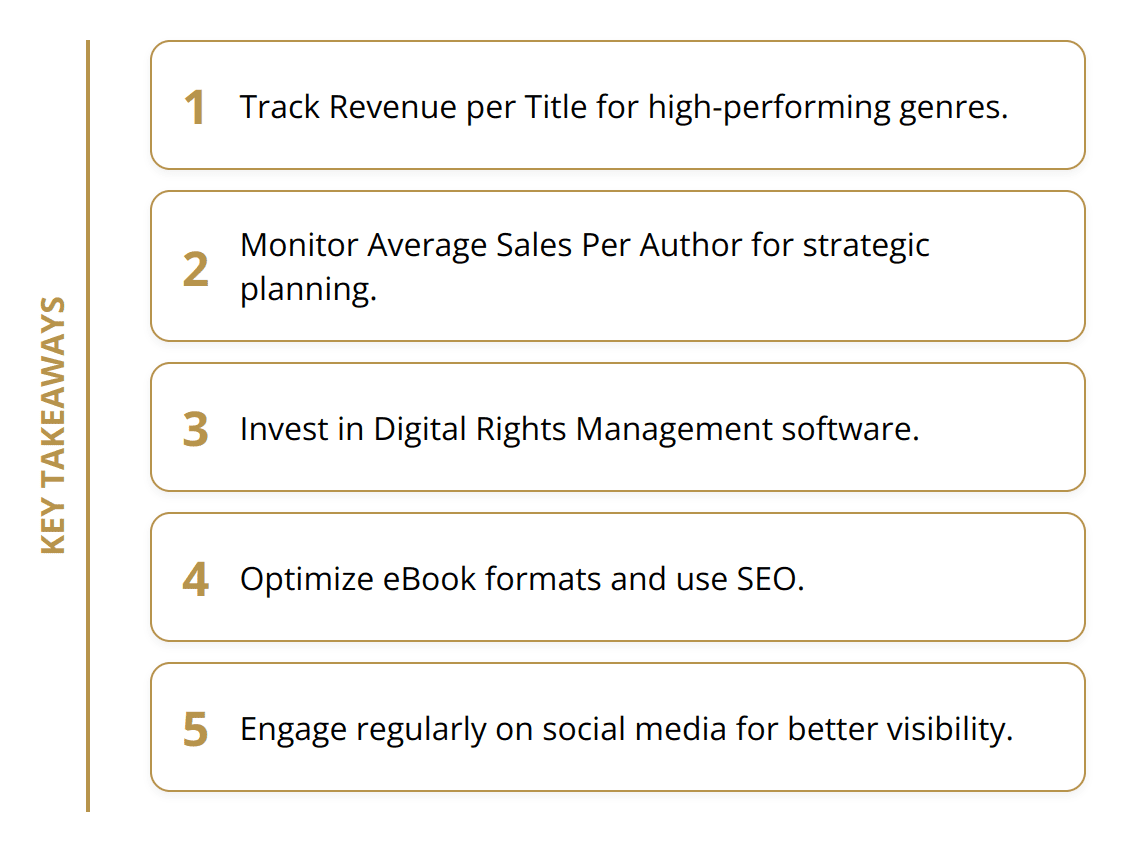Publishing industry benchmarks are crucial for guiding decision-making and long-term strategizing.
Understanding current metrics and trends can help publishers, authors, and marketers stay competitive.
At Beverly Hills Publishing, we aim to provide practical insights that highlight both challenges and opportunities in the evolving publishing landscape.
What Are Key Metrics in Publishing?
For those in the publishing world, understanding and benchmarking key metrics can enhance decision-making and overall strategy. Let’s discuss some critical metrics that can steer your publishing strategy effectively.
Revenue per Title
Measuring Revenue per Title is vital. It offers insights into which genres and specific titles are most lucrative. On average, fiction books tend to outperform nonfiction in revenue, accounting for over 40% of book sales in the US. Tracking the revenue from each title will help identify which topics or styles resonate most with your audience, allowing for better resource allocation.
Average Sales Per Author
Keeping an eye on Average Sales Per Author is essential, especially for long-term planning. This metric provides a clear picture of how well an author’s work performs over time. In 2022, the average American read 12 books per year, so calculating this metric gives publishers and authors an idea of where they stand relative to market consumption. It can guide marketing efforts, focus author development, and even influence book release schedules to optimize sales.
Return on Marketing Investment (ROMI)
Marketing budgets can be substantial. Hence, tracking your Return on Marketing Investment is indispensable. A study shows that shifting even a small percentage of your marketing budget to digital strategies, such as social media and email campaigns, can yield higher results. Tools like Adobe Customer Journey Analytics can help in tracking and optimizing these efforts. Knowing your ROMI guides your future campaigns, ensuring you spend wisely and effectively.

Key Tips:
-
Track Revenue per Title to pinpoint high-performing genres.
-
Monitor Average Sales Per Author for long-term performance analysis.
-
Use digital tools to maximize your Return on Marketing Investment.

Accurate tracking and assessment of these metrics can lead to more informed decisions, making every book launch more effective and less risky. For deeper insights on publishing industry analytics, feel free to explore further.
What Are the Latest Trends Driving Publishing?
The publishing industry is undergoing significant transformations driven by digital advancements, self-publishing platforms, and social media. These trends are not just shaping the industry but also offering tangible opportunities for growth and innovation.
Digital Publishing Surge
Digital publishing has witnessed substantial growth. In fact, online book sales constitute more than 71% of all book sales in the US. This shift is largely due to the convenience and instant access digital formats provide. Publishers should focus on optimizing eBook formats and employing effective SEO for better discoverability.

Emergence of Self-Publishing
Self-publishing platforms are democratizing the industry. Platforms like Amazon Kindle Direct Publishing and IngramSpark have revolutionized access, allowing authors to bypass traditional gatekeepers. Independent publishers in the US experienced significant sales growth during the pandemic. For authors, this means higher royalty rates and complete creative control, making it an attractive option.
Social Media Marketing Revolution
Social media is fundamentally altering marketing strategies. Platforms like Instagram, TikTok, and Twitter are essential for book promotion. Bestselling books gained popularity through platforms like TikTok. Authors and publishers need to harness social media algorithms. Regular engagement and visually appealing content can significantly boost book visibility and sales.
Practical Tips:
-
Leverage digital tools: Invest in eBook formatting and SEO strategies.
-
Utilize self-publishing platforms: Higher royalties and creative freedom.
-
Maximize social media: Engage regularly and use visually appealing content.

Understanding these trends can offer a competitive edge, aligning publishing strategies with current market demands. For further insights on emerging publishing innovations, visit innovative publishing technologies.
What Are the Main Challenges and Opportunities?
Navigating the complexity of the publishing industry involves understanding both its challenges and opportunities. By addressing these head-on, publishers can better position themselves for success.
Navigating Copyright Issues
Copyright issues present significant hurdles in publishing. Piracy and unauthorized distribution can erode revenue streams. To tackle this:
-
Invest in Digital Rights Management (DRM): Use DRM software to protect eBooks and digital content. This can deter unauthorized copying and sharing.
-
Educate Authors and Readers: Inform authors about their rights and the importance of copyright protection. Educate readers on legal ways to access content.
Adapting to Market Demand Fluctuations
Market demand for books can shift rapidly, influenced by trends, economic conditions, and changes in consumer behavior. For instance, during the COVID-19 pandemic, there was a significant spike in book sales, driven by adults seeking entertainment during lockdowns.
Key Strategies:
-
Use Analytics for Forecasting: Implement data-driven tools to predict market trends. Tools like Adobe Customer Journey Analytics offer insights into consumer behavior.
-
Diversify Offerings: Offer a wide range of genres and formats. This can help mitigate risks associated with fluctuating demand in specific categories.
-
Respond Quickly to Trends: Agile publishing can capitalize on current events or emerging interests. For instance, books gaining popularity through platforms like TikTok can be quickly promoted to capture the wave.

Embracing Technological Advancements
Technology is transforming the publishing landscape, offering new avenues for growth but also requiring adaptation.
Practical Tips:
-
Leverage AI and Automation: Tools for automated marketing and content management can save time and optimize efficiency. For more insights, check out how to automate book marketing.
-
Adopt Interactive Features: Interactive eBooks can enhance reader engagement. Features like embedded videos or clickable links can enrich the reader experience.
-
Invest in SEO: Making books easily discoverable online is crucial. Optimize metadata and leverage keyword research to improve visibility on search engines.
Tackling these challenges head-on while leveraging technological advancements can carve out significant opportunities. The key lies in proactive adaptation and strategic decision-making based on reliable data and market insights.
Conclusion
Publishing industry benchmarks offer critical insights for informed decision-making and strategic planning. Metrics like Revenue per Title, Average Sales Per Author, and Return on Marketing Investment illustrate where to focus efforts for optimal results. Trends such as the rise of digital publishing, self-publishing platforms, and the influence of social media provide clear opportunities for growth and innovation.

The future of the publishing industry looks promising. Digital formats will continue to dominate, with online book sales already accounting for more than 71% of the market in the US. The ongoing surge in audiobooks and eBooks also signals evolving consumer preferences. Additionally, the rise of self-publishing platforms will democratize access, enabling more authors to reach their audiences directly.
Adapting to these trends and leveraging technological advancements is essential. Publishers need to embrace digital tools for marketing and analytics to stay competitive. Authors should focus on building their brand and engaging with readers on social media to enhance visibility and sales. Embracing technologies like AI and automation can streamline processes and improve efficiency.
At Beverly Hills Publishing, we are dedicated to helping authors succeed by combining innovative publishing techniques with strategic branding and marketing. This integrated approach helps authors establish themselves as industry leaders while enhancing their personal and professional brands. To learn more about how we can support your publishing journey, visit Beverly Hills Publishing.
Key takeaways:
-
Understand and track key metrics.
-
Embrace digital tools and platforms.
-
Adapt to market trends and technological advancements.
Staying proactive and innovative will help authors and publishers navigate the evolving landscape and achieve lasting success.







